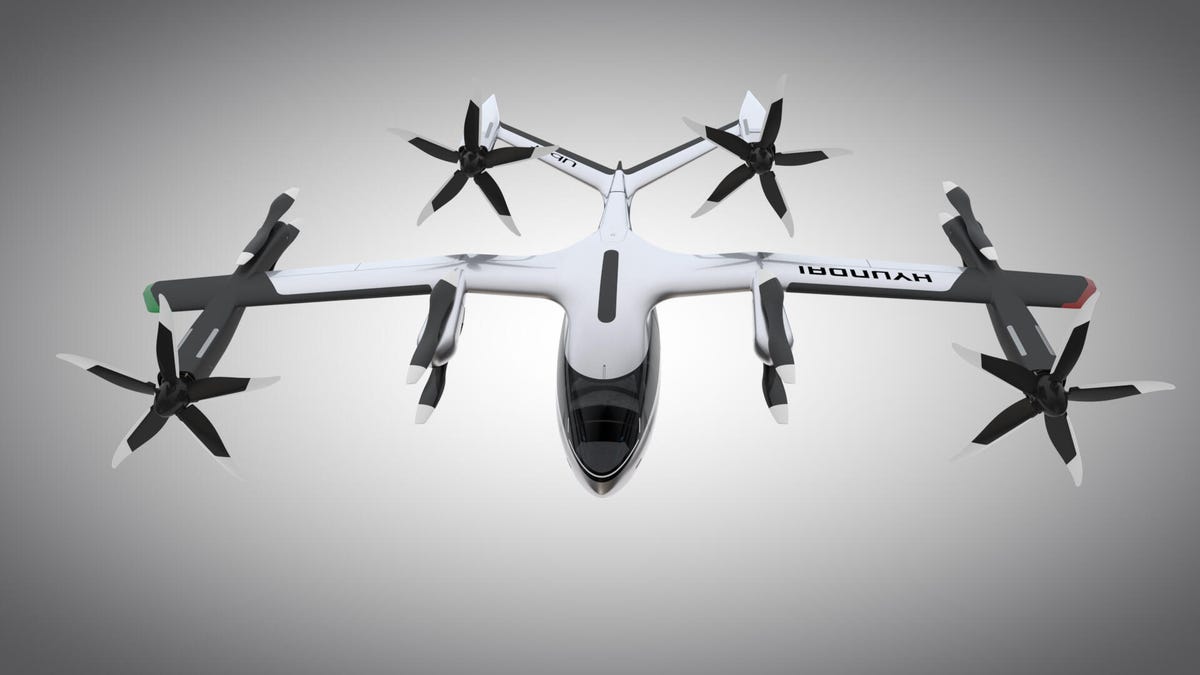Hyundai and Uber Elevate debut urban air taxi concept S-A1
Where we're going, we don't need roads. Meet the electric Hyundai Urban Air Mobility concept, one of a trio of future city transport concepts debuting at CES 2020.

Hyundai Motor Group has partnered with Uber to build vehicles specifically for the ride-hailing service, but not in the way any of us expected. Meet the Hyundai Urban Air Mobility concept, an air taxi concept designed for Uber Elevate's upcoming urban air travel service and part of a trio of future city transport concepts debuted at CES 2020 this week.
Hyundai Urban Air Mobility concept
The Hyundai Urban Air Mobility vehicle is called the S-A1 and was developed in partnership with Uber Elevate, with the air taxi service in mind.
The compact aircraft -- which seats five, including the pilot -- features four electrically driven props in a vertical orientation, much like a quadcopter drone. This gives the S-A1 vertical take-off and landing capabilities and keeps the craft quieter than a traditional helicopter, a combination that Hyundai and Uber think make it ideal for use in urban areas.
Once the craft reaches its cruising altitude, between 1,000 and 2,000 feet, the props tilt to face forward, converting the urban air mobility vehicle to a fixed-wing configuration similar to an airplane. In this more efficient mode, the S-A1 is able to reach a claimed cruising speed of 200 mph with an operating range of around 60 miles. Using these numbers one could imagine a trip from Manhattan to Trenton, New Jersey, from San Francisco to San Jose, or clear across the LA Metro area in about 20 minutes.
Upon reaching its destination, the S-A1 converts back to eVTOL mode before setting down on a helipad -- important for urban use, where there's usually no room for runways. Here's the most interesting detail: Hyundai reckons that with rapid charging, the aircraft will only need about 5 to 7 minutes between trips for recharging. They must be cramming some serious current into that battery.
See also
- CNET's 20 favorite products of CES 2020
- All the cool new gadgets at CES 2020
- Full coverage of CES 2020
The Hub and the PBV
The S-A1 Urban Air Vehicle is, as I mentioned, the first part of a trio of urban mobility concepts debuted at CES 2020. The next piece of this puzzle is the Hub. Hyundai calls the Hub a "mobility space," but I like to think of it as the tiniest little airport designed to fit in tighter city spaces. The small building's purpose is to connect urban air vehicles like the S-A1 with ground transport, featuring a small landing pad on its top and docking bays for multiple purpose-built vehicles radiating from its center.
The ground-transport PBV is the third and final concept and the most in Hyundai's wheelhouse, being a road-bound vehicle with wheels. But it's also the most disappointing, because -- like many "urban mobility" concepts -- it's basically a box on wheels.
This urban shuttle is a fully electric, fully autonomous 13 to 20 foot long box, but we've seen this basic design countless times from the Toyota e-Palette to the Mercedes-Benz Vision Urbanetic. The PBV's flexible, spacious interior can be reconfigured to provide a variety of "tailored services." Passengers might enjoy the services of a restaurant, coffee shop, hotel or even a clinic or pharmacy on the way to their destination. The PBV can also just serve as a shuttle with seats for passengers.
Hyundai imagines urban dwellers would, for example, summon a coffee shop that would take them from home to the Hub, transfer to an air taxi for the longest part of their commute and then pop into another PBV shuttle that drops off at their office.
The partnership
Hyundai joins Bell, Embraer, Joby Aviation, Pipistrel Aircraft, Karem Aircraft and Jaunt Air Mobility as the latest mobility company to partner with Uber Elevate. Most of that list, you'll notice, are aeronautics companies.
Hyundai brings its manufacturing capacity and expertise and experience with mass-producing cars to the table and says it will produce and deploy the vehicles. Uber, on the other hand, will provide airspace support, connections to ground transportation and, perhaps most importantly, an aerial rideshare network -- think Uber Elevate app or an Elevate option in the Uber app alongside XLs and scooters.
Uber has announced a goal of flight demonstrations in 2020 (this year!) with Elevate planned for commercially available to riders in 2023.

